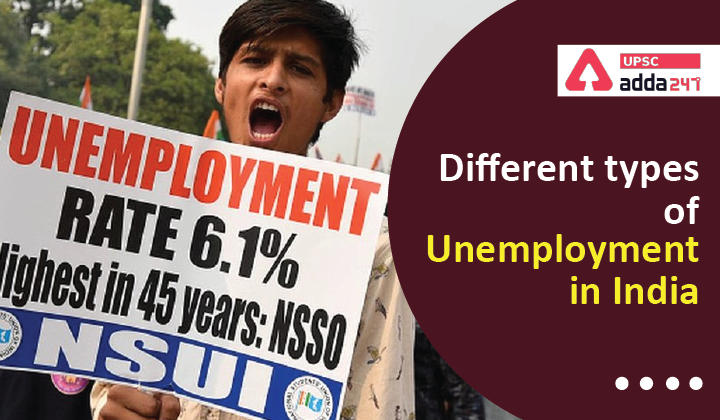Table of Contents
Different Types of Unemployment
Before going to the unemployment types, let us first know what is unemployment?
What is unemployment?
- Unemployment refers to a situation when a person who is actively searching for employment is unable to find work.
- Unemployment rate calculation: Unemployment rate is calculated by dividing the number of unemployed people by the number of people in the labour force.
Get Free Study Material for UPSC and State PCS Examinations
Types of Unemployment in India
Open unemployment
- In this type of unemployment, a large section of the labour force does not get a job that may yield them regular income.
- Here, the labour force expands at a faster rate than the growth rate of economy, due to which all people do not get jobs.
Disguised Unemployment
- In disguised unemployment, more people are doing work than actually required.
- In this situation, even if some people are withdrawn, production does not suffer.
- In other words, it refers to a situation of surplus manpower in which some workers have zero marginal productivity.
- In India, the most common example of disguised unemployment is agriculture sector.
Seasonal Unemployment
- Seasonal unemployment occurs during certain seasons of the year.
- In sectors like agriculture, tourism, economic activities take place only in some seasons.
- These sectors offer employment for only a certain period of time in a year, and people engaged in such type of activities may remain unemployed during the off-season.
Cyclical Unemployment
- Cyclical unemployment is the impact of economic recession or expansion on the total unemployment rate.
- Cyclical unemployment relates to the irregular ups and downs, or cyclical trends in growth and production that occur within the business cycle.
- When economic output falls, the business cycle is low and cyclical unemployment will rise.
- Example: Financial crisis in 2008
Technological Unemployment
- It is a type of unemployment where people could not find jobs due to technical change.
- World Bank predicated that 70% of the jobs in India are threatened due to technological advancement.
- Economists, however, disagree with this type of predictions.
- Economists believes that jobs may be lost for the short time but new jobs appear in other areas.
Structural Unemployment
- Structural unemployment arises due to drastic changes in the economic structure of a country.
- Structural employment is a natural outcome of economic development and technological advancement and innovation taking place all over the world.
- This type of unemployment occurs due to a mismatch between the skills workers have, and the jobs that are actually available.
Frictional Unemployment
- Frictional unemployment occurs when workers are jobless and looking for work in a healthy economy. It doesn’t matter if they leave voluntarily or are fired.
- It is a type of unemployment where a worker voluntarily become unemployed while searching for a better job or moving for unrelated reasons.
- Unlike other types of unemployment, frictional unemployment is a component of the natural labour turnover rate and not a sign of an unhealthy economy.
Chronic unemployment
- If unemployment continues for a longer duration in a country, it is called chronic unemployment.
- Causes: Rapid growth of population and inadequate level of economic development.
Underemployment
- Underemployment is a situation in which people who are employed in an organisation contribute less than their capacity to produce.
- Underemployment occurs when workers’ jobs don’t use all their skills, education, or availability to work.
- Types of underemployments: Visible underemployment and invisible underemployment.
Visible Underemployment
- It includes employees who are willing and able to work more hours but cannot get full-time employment.
- They often work two part-time jobs just to make ends meet.
Invisible Underemployment
- The workers often don’t even realize their skills could be better used elsewhere.
- Invisible underemployment includes workers in full-time jobs that don’t use all their skills.
- This type of underemployment is almost impossible to measure.
- It requires extensive surveying that compares workers’ skills to job requirements.





 TSPSC Group 1 Question Paper 2024, Downl...
TSPSC Group 1 Question Paper 2024, Downl...
 TSPSC Group 1 Answer key 2024 Out, Downl...
TSPSC Group 1 Answer key 2024 Out, Downl...
 UPSC Prelims 2024 Question Paper, Downlo...
UPSC Prelims 2024 Question Paper, Downlo...
